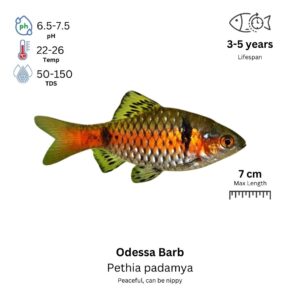Galaxy Rasbora: Species Profile
Characteristics
- Scientific Name: Danio margaritatus
- Family: Cyprinidae
- Origin: Myanmar
- Social Behavior: Peaceful, schooling fish
- Tank Level: Middle to upper regions
- Minimum Tank Size: 10 gallons
- Diet: Omnivore
- Breeding Method: Egg layer
- Care Level: Intermediate
- Preferred pH Range: 6.5 to 7.5
- Water Hardness: 1 to 5 dGH
- Temperature Range: 71 to 78°F (22 to 26°C)
Origin and Distribution
The Galaxy Rasbora (Danio margaritatus), also known as the Celestial Pearl Danio, is native to freshwater ponds in Myanmar, particularly in the Salween River basin area of the Shan Plateau. These habitats are characterized by slow-moving, clear water with abundant aquatic vegetation and rocks, providing shelter, food, and spawning grounds.
Colors and Markings
Galaxy Rasboras are renowned for their striking appearance. They possess a dark blue body adorned with pearly white or yellow spots arranged in a galaxy-like pattern. Their fins are translucent with red or orange hues, often featuring parallel black lines. Males typically exhibit more vibrant colors and a slimmer profile, while females are slightly plumper with subdued coloration.
Tankmates
Due to their peaceful nature and small size, Galaxy Rasboras are best kept with similarly sized, non-aggressive species. Suitable tankmates include:
- Other small danios
- Pygmy hatchetfish
- Guppies
- Molly fish
- Cherry shrimp
- Amano shrimp
- Killifish
- Tetras (regular, ember, cardinal, or green)
- Honey or sparkling gourami
- Cory catfish
- Endler’s livebearer
- Kuhli loaches
- Snails
It’s advisable to avoid housing them with larger, aggressive species that may exhibit territorial behavior or view them as prey.
Care
Galaxy Rasboras are moderately easy to care for but can be sensitive to water quality and environmental changes. Key care considerations include:
- Tank Setup: Provide a well-planted aquarium with ample hiding spots using live plants, rocks, and driftwood. A dark substrate can enhance their coloration.
- Water Parameters: Maintain stable water conditions within the preferred ranges. Regular water changes and efficient filtration are essential to keep ammonia and nitrate levels low.
- Group Size: Keep them in groups of at least six to promote natural schooling behavior and reduce stress.
Diet and Feeding
As omnivores, Galaxy Rasboras thrive on a varied diet:
- Staple Foods: High-quality flake or micro-pellet foods formulated for small tropical fish.
- Supplements: Live or frozen foods such as brine shrimp, daphnia, grindal worms, and micro worms.
- Feeding Frequency: Offer small amounts multiple times a day, ensuring they consume all the food within a few minutes to prevent overfeeding and maintain water quality.
Gender Differences
Males are generally more colorful, displaying a deep blue body with bright red or orange fins, and have a slimmer profile. Females are slightly larger with a rounder abdomen and exhibit more subdued coloration.
Breeding
Breeding Galaxy Rasboras in captivity is achievable with proper conditions:
- Breeding Tank: Set up a separate tank with fine-leaved plants or spawning mops to offer surfaces for egg deposition.
- Spawning: Introduce a conditioned pair or a small group. Females will scatter eggs among the plants, and males will fertilize them.
- Post-Spawning: Remove the adults after spawning to prevent them from eating the eggs. Eggs typically hatch within 2 to 4 days.
- Fry Care: Feed the fry infusoria or commercially available liquid fry food until they are large enough to accept finely crushed flake food or baby brine shrimp.
Further Research
For more detailed information on Galaxy Rasbora care, breeding techniques, and tank setups, consider exploring specialized aquarium literature or consulting with experienced aquarists.
FAQ
How long do Galaxy Rasboras live? With proper care, they can live between 3 to 5 years.
Can Galaxy Rasboras be kept with shrimp? Yes, they are generally safe to keep with small, peaceful shrimp species.
Do Galaxy Rasboras require a heater? Maintaining a stable temperature within their preferred range is essential for their health, so a heater may be necessary depending on ambient conditions.



Reviews
There are no reviews yet.